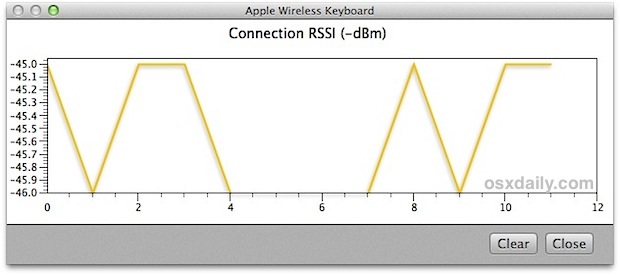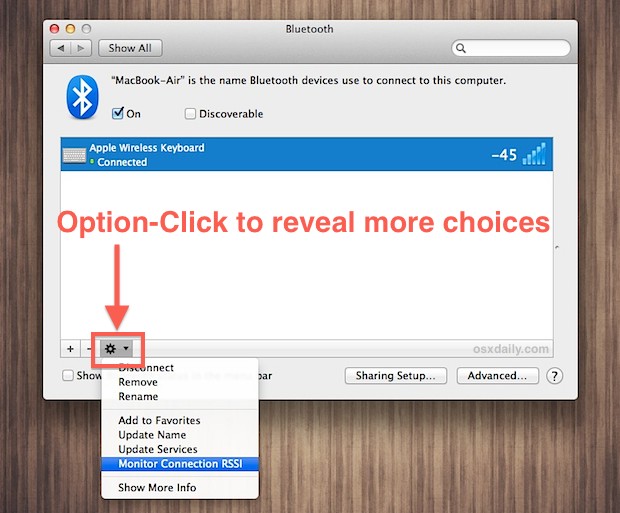Monitor a Bluetooth Device’s Connection Strength in Mac OS X

Those who use external Bluetooth devices with a Mac, whether it’s a keyboard, mouse, headset, or anything else, are probably aware that connection strength between the device and the computer is going to directly impact how usable the device is. The next obvious question then is, how do you check the strength of such a connection? Regular readers may recall a previous tip that allows Mac users to quickly check the signal strength of a connected Bluetooth device, but we’ll expand on that greatly and get a bit more advanced, revealing a live connection monitoring graph that updates the RSSI (received signal strength indicator) of a connected Bluetooth device. This allows for easy troubleshooting when trying to find out if, and help to determine why, a Bluetooth accessory may have a poor connection to the Mac.
Symptoms of a Bad Bluetooth Connection
Symptoms of a weak or bad connection for Bluetooth headsets are audio that cuts out, inappropriately fuzzy audio or bad audio quality, or even no audible sound at all. For things like a Bluetooth keyboard or mouse, a bad connection may range from key presses going unnoticed, mouse movements being imprecise, and erratic cursor control. Gamers and graphic designers in particular are sensitive to shoddy Bluetooth signals since the imprecision of cursor control can make the difference in their activities.
Monitor Bluetooth Device Connections
The connection monitor will only be available to OS X if Bluetooth is enabled and a device is connected to the Mac.
- Open System Preferences from the Apple menu
- Choose “Bluetooth” and select the device you want to monitor the connection for
- Next, Option+Click the little gear icon and from the pulldown menu choose “Monitor Connection RSSI” to bring up the connection monitor window
With the connection monitor visible, it’s time to check and perhaps troubleshoot the devices connection to the Mac.

With the signal graph now visible, let it gather data for a few seconds before jumping to any conclusions. The screenshot up top shows a device reading in the -40 range, which is quite good, and even though it moves around a tiny bit, that is not indicative of an issue.
Reading the Bluetooth Connection RSSI
RSSI can be a bit weird to read, but essentially a higher number means a better connection, and a lower number means a worse connection. Note however that the numbers are negative, so that may read opposite to what you’d expect. For example, a connection of -45 is significantly stronger and better than a connection of -100, which is weaker and more likely to have issues. The rough guidelines below may help read the connection, though the precise signal you get is going to vary on other factors we’ll discuss below:
- -40 to -55 is a very strong connection
- -70 and above represents a good connection
- -100 and below represents a bad connection
- -110 and below is almost unusable
If some of this looks familiar to you, it’s probably because the same RSSI scale applies to those who have enabled iPhone Field Test Mode before, where the numbers seen in the corner that replacing the standard cell bar signals are read the same way.
Taking Action on a Weak Bluetooth Connection
The two most likely reasons for a bad Bluetooth connection are low batteries and heavy interference from something in the environment. Batteries are easy to test, all you need to do is swap in a new set of batteries or charge the device in question and see if the RSSI increases and if the device becomes more stable. Environmental factors can be trickier to track down, but using the live connection monitor can make worlds of difference as you move a Bluetooth device around and watch the graphs response. If you see a huge drop in the RSSI when you move a headset behind a fireplace for example, you can surmise that something in the wall is causing the interference and you should rearrange the equipment accordingly. It’s also vaguely possible that the device itself has a defective antenna, though that’s fairly rare for most quality devices.


Old article, but this tool seems to be missing from macOS Catalina — anyone know if it’s hidden somewhere else? There’s no gear menu in the Bluetooth preferences anymore.
thanks
-Joseph
Also missing from OSX Mojave.
Based on earlier comments, it seems to have disappeared some time between Mavericks and Yosemite.
Sorry, I meant William (author). Or anyone else: know where this real time graph can be found? The problem with option clicking the bluetooth menu bar is one can’t easily see tweaks to configuration in real time. Option clicking with each tweak to check signal strength on 2 BT devices is difficult. Would love to have a real time monitor to see impact as I reconfigure.
Hey dude, I was in the same situation as you where. If you have no figured it out yet, simply download the app called “iStumbler” on your mac and you’ll be able to have the graphs as well as RSSI in real time!
Hey Paul, thanks for the tips. Question since this graph is no longer available in OS X 10.10: Is the REAL time graph still available in Yosemite?
This works for OS X Mavericks, just Option-click on the BT icon in the menu bar (no need to go into System Preferences)
This seems to no longer work in Mavericks. The gear icon is no longer visible after selecting the BT device. Or is it necessary to enable some option to make the gear icon visible?
Where can I get that wood wallpaper? It’s so cool man :)
Hey guys! I’ve found it thanks to google images recognison!
Here it is folks:
http://wallpaperscraft.com/image/stripes_patterns_vertical_texture_50950_1280x720.jpg
You can find more of them here:
http://www.picstopin.com/2560/stripes-pattern-texture-wallpaper-x/http:%7C%7Cwww*pulsarecard*com%7Cdata%7Cmedia%7C18%7CV_Stripes_By_Dreamaster117_2560X1600*jpg/
My Adesso bluetooth keyboard has a strong signal between -58 to -68 db, but the problem I have is that the OS does not connect to it automatically very well. If the keyboard is idle for a while the connection will drop to save battery life presumably, but then when we try to wake up the keyboard we have to go over and manually tell get the Mac to try and connect to the keyboard again.
I got the adesso keyboard, because it has a built in track pad which I have connect to a home entertainment Mac. The connection drop problem means I have to keep a regular keyboard and mouse connected to the Mac so I can kick start the bluetooth connection. At this point we mostly use the USB attached keyboard with a long cable since waking up the bluetooth connection is a pain in the butt when you want to pause a movie. Any body have any suggestions for getting the Mac to keep the bluetooth connection alive?
Although your tips imply that your instructions fit all levels of Mac OS 10, they do not fit my set-up: G4 intel lap top using OS 10.6.8. There is no “Monitor Connection RSSI” in gear icon’s pulldown menu. When you post a tip, would you be willing to state exactly what system levels it fits? Thanks.
This particular tip applies to OS X 10.7 and later, and it works in OS X 10.8.2. We simply don’t have the resources to test every individual OS X configuration and system version, so sometimes we rely on our readers to confirm that things work in older versions. Thanks for understanding!
You don’t even need to Option click the gear because once you press Option it shows a little graph with the number next to the device in the list. At least that’s what it does in MT.
This is a great tutorial, but I have a silly question… how are we supposed to know what the battery level is of Bluetooth devices? Just wait for the connection to get bad? Is there an easy way to check the battery level?
Thanks for everything!